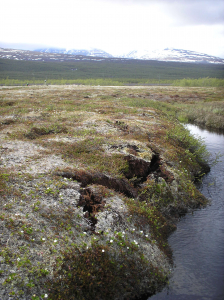Chukchi Sea Ecosystem Study
What Are They Doing?
 Lowering sampling instruments into the Chukchi Sea
Lowering sampling instruments into the Chukchi Sea
This project attempted to understand the role of carbon resources to the food webs of the Chukchi Sea, off the northwest coast of Alaska. The northern Chukchi Shelf receives large inputs of organic matter transported from the highly productive shelf regions of the North Pacific and from existing sources of primary production, including ice algae, sediment microalgae and phytoplankton. These contributions of highly changing organic carbon, together with potential benthic (from the bottom of the sea) sources of nutrients, likely contribute to the enormous secondary production (production of living material by organisms) of this region. In particular, the relatively shallow depths (40-55 m) and high bottom flow have created "hotspots" of biological productivity found in the vicinity of the Hanna Shoal region of the Chukchi Sea.
The research team included scientists from seven institutions and two federal agencies. The work took place over dozens of existing sampling stations and involved collaboration with other science studies in the region sponsored by federal, state, or industry interests. Due to the biological significance of this region and its importance for oil and gas exploration and development, the group examined the range of biological, chemical, and physical properties that define this ecosystem.
The group focused their efforts on the Hanna Shoal region, with the addition of a pelagic (from the open ocean) component to address standing stocks of phytoplankton and zooplankton, and a physical oceanographic study that addressed water mass movements through direct measurement of circulation, density, and ice conditions.


 Traditional blanket toss in Barrow, Alaska
Traditional blanket toss in Barrow, Alaska


 Female wolf spider in Alaska
Female wolf spider in Alaska

 Thawing permafrost
Thawing permafrost

 Arctic Ground Squirrel
Arctic Ground Squirrel

 Trawling catch in Antarctica
Trawling catch in Antarctica

 Lake Kevo in northern Finland
Lake Kevo in northern Finland

 The Alaska Range near Denali National Park
The Alaska Range near Denali National Park

 Experimental drying plots on the tundra
Experimental drying plots on the tundra
